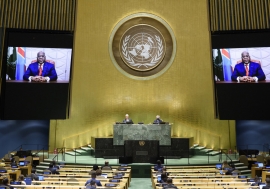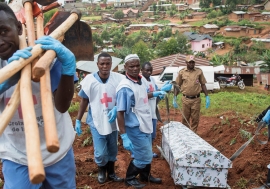The Democratic Republic of the Congo is, alongside Afghanistan, Yemen and Syria, among the World Food Programme’s biggest emergencies – reeling from decades of conflict and climate change that continue to reduce people’s access to the most basic foods, increasing hunger to unprecedented levels.
As WFP grapples with a global funding crisis and growing humanitarian needs, the horrific stories – not least of sexual violence – unfurling in the east of DRC beg a simple question: how is it that tragedy on such a scale receives so little attention?
To find out more about the challenges DRC faces, we spoke to Natasha Nadazdin, WFP's Deputy Country Director in Kinshasa. For with all eyes on the African Cup of Nations, it's perhaps a moment to reflect on what might be possible for the children of DRC – and, for that matter, children across the Continent – if they were to receive the nourishment, education and training they need to create a level playing field both on the pitch and off.
Could you describe the situation in DRC?
Things are so bad, so seriously challenging for people, and at a scale so vast, that, amazingly, its problems seem to have fallen off the international news agenda altogether; a state of tragedy for millions is widely regarded as the country’s default, its lot, as dozens of armed groups compete for its natural bounty.
Struggles for power – and not just those within the country – have plunged the east of the country in particular into a ruthless cycle of conflict and insecurity. More than 6 million people are displaced and cut off from their pastures – including 720,000 people who’ve fled their homes since October. Livelihoods are trashed. Reports of women and girls being raped are depressingly frequent as lawlessness exposes tens of thousands to gender-based violence.
Then there is DRC’s ‘resource curse’ – demand for minerals such as cobalt, gold, and copper is mega-high around the world, but there is nothing in it for those uprooted from their homes, as wealth does not trickle down to the poorest.
Give us a sense of the scale?
More than 25 million people – a quarter of the country – are at IPC3 or IPC4, the ‘crisis’ and ‘emergency’ stages of the global standard for measuring food insecurity (with IPC5 being ‘catastrophe’ and ‘famine’).
Decades of conflict, dozens of armed groups, political instability – the list of course goes on – intersect with climate change, so that every day is even more a matter of survival for the Congolese.
Droughts, floods and other climate impacts decimate crops. Where food is grown, farmers struggle to access markets. Roads and bridges are often destroyed or blocked, resulting in food loss as trucks are forced to take substantially longer routes to get from A to B.
And easing pressures starts in the east?
While it is important to recognize the unique dynamics in each region, addressing the issues in the conflict-riven provinces of Ituri, North Kivu and South Kivu would contribute to improving the overall stability and development of the DRC.
But this requires peace and the safe return and resettlement of the displaced population.
Back on their land, their work would invite investments in rural infrastructure and resilience-building activities. It would also require the reintegration of combatants into a workforce that can help DRC not only fend for itself in terms of agriculture but also export food.
What does WFP need for the next six months?
WFP’s absolute minimum plan for 1.5 million of the most vulnerable is facing a net funding requirement of US$381.2 million for the next six months. But to keep our wider operations going we need US$567.8 million.
How are we dealing with this shortfall?
We call it extreme prioritization: providing full rations for six months to a lower number of people rather than spreading assistance too thinly such that no one is adequately served. It’s a painful decision – which is why we urgently need funds.
Could you describe our work with other agencies?
WFP works closely with agencies such as FAO and UNICEF, especially in Tanganyika and Kasai provinces.
Projects supported by Sweden and Norway promote the links between humanitarian, development and peace work. So, there is a response to immediate needs while reducing long-term needs thanks to economic, social, technical and resilience activities to improve people’s ability to respond to crises.
Over the past year, WFP has conducted several conflict-sensitivity analyses to better inform its programming, including through a joint project with FAO in the Kasai. The protection of the people we serve is at the heart of WFP's interventions.
That takes us back to the problems faced by women and girls
Women living in displaced camps have the impossible choice of letting their families go hungry or facing sexual violence as they venture out to find food and firewood, or are forced into unsafe strategies such as prostitution to survive.
A mix of reasons lies behind the alarming uptick: from highly unequal gender relationships, a culture of impunity, a weak justice system, displacement and unsafe living conditions, to hunger and poverty, deepened by a lack of access to food and insufficient funding for humanitarian assistance.
Regular and predictable food assistance can mitigate some of these survival strategies. At WFP, we are keen to highlight the links between food insecurity and the elevated protection risks that women face in eastern DRC. While providing food assistance and other needs – such as shelter, water and sanitation – is essential, joint advocacy, integrated solutions and programming are needed with many partners and stakeholders.














